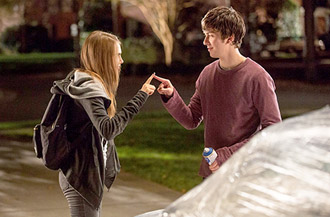Book vs. Movie: Paper Towns
By Ben Gruchow
August 10, 2015
There’s a little concerned observation by the narrator that the things which used to matter to him - graduation, college, predictability, et al - matter less in the face of his search for a once-friend, but only a little; the novel avoids any serious sense of repercussion or consequences for Quentin’s impulsive actions. In doing so, it allows the middle of the book to focus squarely on what he’s thinking.
The mechanics of this thought, and the tendency of all characters involved to begin revisiting and second-guessing their own convictions, is what gives Paper Towns its thematic identity: conceptually, it’s about building up a person to be a certain way in one’s mind, constructing neuroses and thought-patterns and wants and needs by a combination of wishful thinking and imprinting one’s own personality onto another individual’s, and expecting them to act in accordance with that fabricated code. This is certainly done by Quentin with Margo, but it’s also enacted by Radar with his girlfriend Angela, and by Quentin toward Ben.
The fulfillment of this theme is pretty easily guessable, and it’s to the novel’s credit that it doesn’t really try to hide its ultimate statement: that this type of personality construction is really no more than a slightly cushioned way of “other-ing” a person, and denying them the legitimacy of their own identity in the face of a preconceived one; consequently, the people who are put on this type of pedestal never end up reacting the way they’re expected to, and express confusion at the presumption and identity more or less assigned to them by the initiator.
The book contains trace explorations of other themes, and feints toward other genres (there is a passage set in a strip mall, one of the first places that Quentin’s scavenger hunt leads him, that edges on darker and creepier narrative territory before backing off) but most of its substance exists under this main storyline.
The Movie
First things first: The movie version of Paper Towns drastically cuts back the presence of Quentin’s parents, which can’t help but improve its standing there relative to the novel. Also, the store that Quentin and Margo visit in the middle of the night during their trip is an anonymous wholesale/Walmart hybrid, rather than the novel’s Publix (there is no Publix on Earth that I know of that is open past 10:00 p.m. - an incredibly spurious point, but it’s nagged at me since I read it).
Past those two improvements, what have we? The movie adaptation covers just about the exact same story beats as the novel, with one minor difference that gives the movie’s ending a slightly different flavor than the book’s (and it is ultimately very minor; sort of like the difference between Sprite and Sierra Mist).
Nat Wolff and Cara Delevingne step in for our two main characters; I’ve covered the details of Wolff’s performance elsewhere, but the application of the actor in the sense that he appears may be responsible for the movie version of Paper Towns locking us out of Quentin’s headspace, where the majority of the book’s middle part took place. Instead, the simple existence of the scavenger hunt for Margo occupies most of the movie’s substance, suppressing the story-long examination of what it’s like to de-humanize a person and put them on a pedestal. As a result, what we’ve got is a sort of light mystery with the sociological and school-related incident foregrounded.
Continued:
1
2
3
4
5
|
|
|
|




